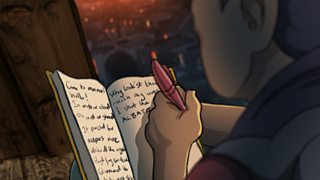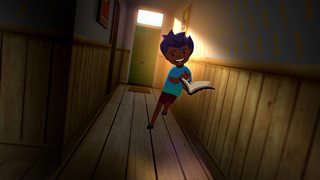10 Tips To Bring Your Story To Its Perfect Conclusion
So you’ve got a great plot, a perfect protagonist but you can’t quite nail that ending... So, to bring your story to its perfect conclusion, here are some common tricks novelists use to bring their plot to a conclusion. How will your story end?
A Cliff-hanger
Some time ago, there was a popular film called ‘The Italian Job’. In it, a group of crooks steal some gold. After a dramatic and eventful car chase from the cops, they find themselves in the most precarious of situations… in a van teetering on the edge of the cliff. Sliding towards the back of the van is a huge pile of shimmering gold bars. They know that the only way to prevent the van from sliding off the cliff, is to stay at the front of the van. But the temptation to try to grab the gold is oh-so overpowering. The film ends with one character announcing that he has a ‘great idea’…
This ending is brilliant because it leaves the audience wondering: what might this great idea be? Do the crooks survive? and do they make it away with the gold?
Remember, however, that a cliff-hanger needs to leave the reader with a host of questions and a range of tantalising possibilities for the characters in it. A cliff-hanger is not simply achieved by stopping your story short!
A Twist: the butler did it

Lots of really great stories deliver a twist towards the end of the tale. Remember, however, that the twist must be satisfying. If you’re writing a whodunit and the twist reveals that the criminal is actually someone never mentioned in the story before, we as the reader would feel cheated – it’s just not fair to spring that on us! But if the twist is that the Butler was actually the victim’s long lost father …then you’ve successfully delivered something surprising to us about the plot that we’ve been reading.
Be careful of stories about inanimate objects, where the twist reveals the true identity of the object. It’s a common thing taught in schools but can be very disappointing as a read. Avoid “it was all a dream” twists too!
Your Character Learns Something
As readers, we invest a lot of energy in getting inside the head of the main character in a story. We often will them on to realise or learn something, and see a way forward for them before they do themselves. A neat way to bring your story to a close is to satisfy your reader’s desire for the main character to have learnt something. Perhaps if they’re the baddy, they might realise that it’s too tiring being evil all the time – or if they’ve spent their story with a crush on the Prince, they might realise they actually prefer being a strong single lady!
Your character doesn’t have to change at the end of a story. Some of the best truly evil characters of all time realise at the end of a story that they simply LOVE being a meanie.
The Situation Resolution

Many stories revolve around a situational dilemma – where a character is put into a situation that they have to react to (rather than creating a set of circumstances around them). A situation might be as big as a war, or as small as an empty fridge and a rumbling belly. A good resolution to a situational story will see the sailor survive despite the terrible storm, or the superhero triumph despite all the evil in the world.
Going Back To Square One
A story doesn’t need to be linear – that is, it doesn’t need to start at the beginning and take us forward in time. It can start at the end of the day and be a flashback about how the character got there. Sometimes, adding this context to the character’s situation can be thrilling. If, at the start of a story we see a character holding a bag of money over the edge of a ship, we’ll wonder if they’re mad. But if the story goes on to tell a tale of how that money was stolen earlier in the day – well, that’ll give us a totally different viewpoint on their actions by the end of the story.
Hint At What's To Come

Wrapping things up for the reader doesn’t need to mean over-explaining. If you’re writing a romance, you don’t need to tell us that the couple married and adopted a beautiful family and lived happily ever after. You could simply say ‘Fred and Albert looked into each other’s eyes and saw the future which lay ahead of them’. Your reader will work out the rest.
Make It Moral
Lots of stories have a moral to them, or leave their reader feeling like they’ve learnt something. Read your story over and ask yourself whether it’s clear what the underlying moral is. If it isn’t, perhaps your ending may need to be tweaked to evoke a stronger emotional response in your reader. What lesson are you trying to teach us? What point are you trying to prove?
One True Sentence

A lot of writers start their stories by writing down One True Sentence. That is, something they know fundamentally to be true. ‘Animals do not speak’, ‘no one lives on Mars’. Then, their story goes on to either prove that statement to be true, or subvert it. Sometimes, using this One True Sentence at the end of a story instead, can seal a tale with a huge dash of humour or irony. Give it a go and see if it works for your story.
Ticking Time Bomb
If you’re really struggling to contain your plot within 500 Words, why not try to use some kind of time limit within your plot? This might be a countdown until that chocolate cake goes mouldy, or something much bigger like the countdown to a rocket launch.
Make Us Laugh

Injecting some humour into your tale can be a brilliant way of rounding it off. This can be achieved by highlighting how ridiculous a situation is, like Yann Martel did in the book Life of Pi:
"Very few castaways can claim to have survived so long at sea as Mr. Patel, and none in the company of an adult Bengal tiger."
More from 500 Words
-
![]()
500 Words 2020
Everything you need to know about this year's competition.
-
![]()
Submit a story
All the information you need to enter the competition.
-
![]()
Everything you need to know about Radio 2's short story-writing competition for kids.
-
![]()
10 Great Opening Lines From Literature
The best opening sentences in literature, according to 500 Words judges.















































